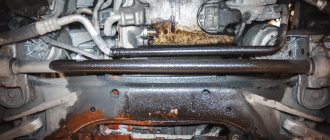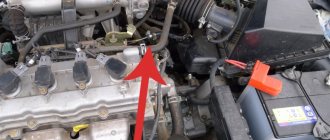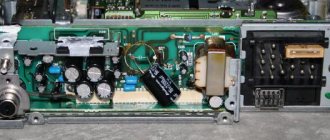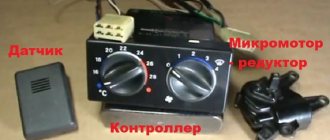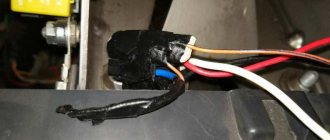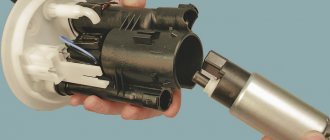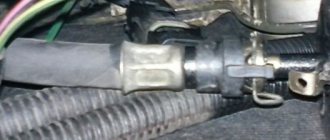If you smell antifreeze in the cabin, this is an alarming sign. Don't think that ventilating your car is enough. It's not just about the unpleasant smell. Harmful fumes can harm the health of people inside, and leakage of antifreeze will lead to technical problems. Hanging scented trees around the cabin is not an option. If the interior smells of antifreeze, you need to diagnose the cooling system. There is nothing complicated here - you will see for yourself now.
Why does the smell of antifreeze appear in the cabin?
Sometimes an unpleasant odor appears even with normal sensor readings.
Ventilating the interior gives a temporary result - when the window glass is lifted, the problem manifests itself again. To completely solve it, you will have to establish its source. Typically, the cause of the odor is an antifreeze leak. The cooling system mechanisms fail as a result of prolonged use. The expansion tank itself could be depressurized or initially be of poor quality.
An antifreeze leak sometimes appears after an engine repair - if one of the hoses was connected incorrectly. Leaks can be quite difficult to detect. The fact is that antifreeze actively evaporates, and with a minor leak, the inspection may not yield results. But if the leak is quite severe, it can be easily detected by characteristic spots on the parts of the power unit. In this case, traces of coolant are also visible on the asphalt while the car is parked.
To ensure a high-quality connection of the cooling system hoses, use special metal clamps. They are reliable and can be used for a long time. Check the radiator. If it becomes depressurized, it is better to replace it, since it is difficult to repair the device.
Smell of fuel
Most of us are familiar with the standard smell of fuel, both gasoline and diesel. And if you encounter a similar phenomenon, there may be a substance leak somewhere. The intensity of the odor is strong enough to determine where the leak is located. In most cases, the source of the “aroma” is a crack in the fuel tank, leaking injectors and other elements of the fuel system.
Possible consequences and solutions
The antifreeze leak problem has several negative consequences.
- Technical. A leak will sooner or later lead to a critical drop in the antifreeze level and engine overheating. The coolant in the cabin will lead to accelerated oxidation of the contacts of the on-board electronics, since antifreeze is partially composed of water. And if there is a large coolant leak, this problem can even cause a short circuit in the electrical wiring.
- Operational. Systematic fogging of windows due to condensation of antifreeze leaving the system will constantly reduce visibility. The risk of getting into an accident will increase. Excessive humidity in the cabin will lead to the appearance of fungus and mold. And this is an additional source of unpleasant odor.
- Physiological. Ethylene glycol, the main component of the vast majority of modern coolants, is toxic to humans. The lethal dose ranges from 100 to 300 grams. In volatile form, when ingested through the respiratory system, its concentration in the body rarely reaches a dangerous level. However, systematic inhalation of vapors may cause dizziness, nausea, coughing and irritation of the mucous membranes. In addition, the smell of antifreeze is not pleasant for everyone and can become an additional irritant.
The best solution in this situation is repair and replacement of damaged elements of the cooling system. As a temporary measure, it is possible to use repair sealant for the radiator.
If you have all of the above, you can start replacing
We choose a place for repairs. You can have a flat area or an inspection hole;
We turn off the engine, put the handbrake on, turn the rocker into neutral, wedge the wheels diagonally with boots;
We let the engine cool down after work, and also for safety reasons, since you can get damage to the skin, because the coolant can reach 90 degrees Celsius. Remember that it is necessary to carry out diagnostics and replacement only with rubber gloves;
After the engine has cooled, place a drain container under the radiator and unscrew the cap of the expansion tank . to avoid a vacuum, unscrew the drain valve on the radiator and drain the antifreeze or antifreeze;
Without closing the lid, wait until the liquid drains. Using a screwdriver, loosen the clamps and remove the pipes that go from the thermostat to the stove heater, as well as the pipes on the reverse side, from the passenger compartment.
Remember that a common reason for the inoperability of the stove tap is the “coking” of the walls by formations from low-quality coolant;
After removing the pipes, be prepared for residual antifreeze to flow from them. Be careful;
Reasons for the smell of antifreeze in the cabin
The sweetish smell of antifreeze in the cabin, especially noticeable after turning on the heater, always indicates one thing: there is a coolant leak in the system. There are four main ways antifreeze vapor can enter the cabin.
- Through a leaky heater core. This is the most common reason. If the smell is pronounced and is accompanied by leaks of antifreeze into the interior or systemic fogging of the car windows from the inside, then most likely the heater radiator is leaking. For example, on VAZ 2114 cars (and all models of the 10 series), as well as in the first generation Kalina, the heater radiator is made of two plastic reservoirs connected to aluminum honeycombs with fins. Leaks usually occur at the junction of plastic and metal. On more recent VAZ cars, such as Granta, Priora and Kalina-2, the heater radiator is all-aluminum. It usually destroys the honeycombs or breaks the supply pipes.
- Damage to the radiator supply or outlet pipes at their base. In this case, usually only an odor is observed in the cabin. There is no fogging of glass or smudges, or these factors are not clearly expressed. Depressurization of the system for this reason usually occurs at the joints. The pipes themselves are less likely to be damaged.
- Insufficient tightening of the clamps on the heater radiator pipes. Antifreeze leaks into this connection quite often. The most repairable fault. Eliminated by tightening the clamps.
- Violation of the integrity of the cooling system in any place other than the heater. In this case, only a slight smell of antifreeze is possible in the cabin. The entire engine compartment will also smell of antifreeze. The problem is usually accompanied by a sharp and noticeable drop in the coolant level in the expansion tank and overheating of the car.
There are several reasons for the destruction of pipes, radiators (central and heater), as well as other elements of the cooling system:
- low quality antifreeze;
- periodic use of water instead of a suitable coolant;
- untimely replacement of coolant;
- cavitation destruction;
- excess pressure in the system due to problems with the steam exhaust valve;
- overheating with boiling of liquid;
- natural wear and tear.
When the smell of antifreeze first appears in the car interior, you need to check the tightness of the system. Please note: some antifreezes contain special fluorescent components that glow under ultraviolet radiation. This helps to find even a small leak.
You may also be interested
Why antifreeze curdled: reasons and what to do
In some cases, a motorist may find foamed and heterogeneous rust-colored something under the cover. In this case, experienced drivers state: “The antifreeze has curdled.” Why does this happen and how to deal with it? This is exactly what we will discuss with experts in an article on our website.
Why does antifreeze foam and foam form in the expansion tank?
A car with poor heat dissipation from the engine is sensitive to any overheating. If the antifreeze foams, this indicates problems with its composition and requires attention from the car owner. Let's talk to experts about what to do in this situation.
Signs of a coolant leak
The smell of antifreeze in the cabin clearly indicates a malfunction in the car, regardless of the amount of coolant leaking. In most cases, such a malfunction is caused by a broken pipe or radiator. To do this, you need to carefully inspect all the parts under the hood to find any damage. The problem could also be due to a cracked radiator hose or a faulty gasket. It is much more difficult to notice the problem here.
The main sign that antifreeze is leaking is a specific smell in the cabin. The problem may also be accompanied by wet floor mats. In this case, the breakdown must be repaired immediately, since inhaling coolant vapors can lead to poisoning of the body with toxic substances.
We recommend: Learning to drive - how to quickly get behind the wheel
Another sign that antifreeze is leaking may be an increased engine temperature. As a rule, an indicator light on the control panel lights up when the antifreeze value is critically low.
Step-by-step instructions for replacing the VAZ 2114 heater radiator
- The first step should be to drain the coolant, which will then need to be replaced. Next, you need to move inside the car and unscrew the self-tapping screw, which is located under the plastic plug, as shown in the photo.
Unscrewing fasteners on the dashboard
The radiator can be removed through the slot
What can a breakdown lead to?
We found out that the unpleasant odor is caused by a coolant leak. This leads to overheating of the engine - which can result in breakdown. Fumes are harmful to health - especially in the cold season, when the smell of antifreeze in the cabin only intensifies when the heater is turned on. Therefore, in winter, the malfunction must be eliminated even more quickly. You can do it yourself, but if you don’t have the skills, it’s better to turn to the experts.
A malfunction can add the following problems:
- Carpet, ceiling upholstery, sound insulation and other materials inside the cabin actively absorb and accumulate odors. Over time, they will become saturated with the unpleasant smell of antifreeze. It will always accompany the driver; no fan will help here.
- The coolant will leak out all the time - you will have to spend money on constant replenishment.
- The antifreeze that has dried after leaking crystallizes; these unnoticeable “crystals” will “flavor” the car’s interior.
It is not easy to determine the fact of a leak if the coolant gets under the timing drive. But upon careful inspection of the space under the belt, characteristic marks can be detected. Antifreeze can also get on the belt itself. This will cause the destruction of its structure. Typically, the cause of moisture on the timing belt is a faulty pump.
Operating principle and replacement algorithm
Replacing the heater tap on a VAZ 2114 can take place both in a “garage” environment and at a certified car service center. Considering that a trip to the service station will cost us a tidy sum, we will carry out the repairs ourselves. To do this we need to prepare:
1) A container for draining antifreeze with a volume of at least 7 - 8 liters;
2) New stove heater valve;
3) A canister with new antifreeze or antifreeze;
4) Car portable tool kit;
6) Shoes made of wood or metal;
How to find the cause of the breakdown?
The coolant constantly decreases while the engine is running. In winter, antifreeze evaporates when cooled. But all this is a normal operating process and does not cause the smell of antifreeze in the cabin. If the coolant comes out in large volumes or is consumed faster than expected, then we can talk about a malfunction.
How to find the cause of a breakdown based on symptoms?
- Damaged tank or cap - in order to detect the problem, a visual inspection of the antifreeze tank will be enough.
- Malfunctions in the heating radiator system - in this case, an oil puddle of antifreeze condensate will form under the front seats (both passenger and driver), and excessive fogging of the windows will also occur.
- Problems with radiator pipes (damage, chips, cracks or loose fittings) – leaks may occur at the joints. To check this, you need to put cardboard under the car for a day. Then it should be checked for oil stains: if there are any, then it is worth checking all the pipes for functionality.
- A leak in the engine is the most unpleasant situation when it is almost impossible to find the cause of the breakdown on your own. You can diagnose an antifreeze leak into the engine by unscrewing the spark plugs. If there is a white coating on them, it means that antifreeze is still leaking out.
- Leakage into the oil - in this case, the smoke from the exhaust pipe, which comes out when the engine is running, has a light tint and a sweetish smell of coolant is felt.
2 Damage to VAZ cooling system hoses
Another reason why refrigerant leaks is a rupture or damage to the hoses at their connections. This situation is relevant for VAZ 2114 of early production years, as well as for cars that have not been serviced for a long time. Under the influence of temperature changes, hoses lose their physical abilities, begin to wrinkle and burst. That is why experts strongly recommend replacing all car hoses every 2 years.
Damage to hoses at their connections
Due to the specific location of the channels under the hood of a car, a broken hose or damage to the radiator is very easy to determine by the presence of droplets that the refrigerant leaves. They can be located not only on the floor in the front of the VAZ 2114, but also on the throttle valve, in the engine cylinders and on the throttle position sensor. In addition to replacing faulty parts, drivers are forced to clean the throttle body and wipe the engine of their car.
Another well-known reason for antifreeze loss is pump depressurization. It is located at the bottom or middle of the engine. If you notice the presence of moisture at the pump installation site, then antifreeze is flowing through it. Very often this malfunction is confused with the driver’s banal inattention when he forgets to tightly close the drain tank after replacing the antifreeze.
Closing the antifreeze reservoir
Each of these breakdowns requires not only replacing the worn part, but also performing other work: ventilating the interior, cleaning parts in the engine compartment. Some drivers, having discovered that they were leaking refrigerant, were forced to change electrical wiring and transmission parts. Therefore, if you notice that the coolant is leaking in your VAZ 2114, do not wait under any circumstances, but immediately determine and eliminate the cause of the breakdown!
There are many loopholes in the engine compartment through which refrigerant can leak. For example, through the seal on the radiator drain plug, through its pipes, the water pump oil seal, or through the car oil heating system. One way or another, refrigerant is a component of the car’s cooling system. Therefore, if antifreeze is leaking, then it is necessary to look for the cause precisely inside the parts that are located near it.
Coolant leak through radiator drain plug
If you notice that the refrigerant is leaking in your VAZ 2114, then the first thing to do is replace the hoses through which the liquid circulates to the engine. This system repair method will help block the antifreeze exit paths. And even if it’s not just the hoses that are faulty, replacing them will still reduce refrigerant leakage and give you the opportunity to safely drive to the nearest service station.
Replacing Cooling System Hoses
You can purchase hoses for replacement in the cooling system at any auto store. When purchasing them, pay attention to the method of fastening the channels and their length. For the VAZ 2114, hoses with a length of no more than 80 cm are considered acceptable. The method of attaching standard pipes for antifreeze is standard, two-channel.
What should a car enthusiast do?
First of all, carry out a complete diagnosis of the car's cooling system. This can be done in the garage, without complex devices and without special knowledge and skills. But you need to carefully remove the smell of antifreeze. Open the hood, check the pipes, hoses and covers for visible damage. Absolutely all system conductors must be checked. We replace damaged parts.
Another cause of a leak may be a malfunction in the engine crankcase. Failure leads to disruption of the functionality of the power unit. To diagnose, just look at the oil tank cap from the inside. If coolant gets on the engine crankcase, a white coating forms on the cover.
As a result of the leak, coolant can penetrate directly into the passenger compartment. This indicates a malfunction of the radiator. If a leak forms in it, some of the coolant penetrates into the cabin, where a characteristic sweetish smell is felt. We replace the radiator with a new one and remove the liquid. This can be done by placing newspapers on the puddle, which we throw away as they become soaked. Someone uses a plastic bottle. We make a hole in its lid, then squeeze the bottle to release air from it and apply the hole to the spilled moisture. In 3-4 passes, you can “suck out” the entire puddle in this way, and wipe off the remaining moisture with a rag.
The cause of the leak can be difficult to determine. If the source of suspicious traces cannot be identified, look at the radiator of the heating system. Coolant may also leak from the heater. Then an unpleasant burning smell is felt in the cabin. Leaking liquid will get under the mat. To fix the problem, you will have to replace the stove radiator by first disassembling its body.
The reason may not be in the radiator itself, but in the tubes connected to it. The joints can be treated with sealant. But it is better to immediately replace the problematic tubes with new ones.
To prevent the appearance of coolant vapors in the cabin, you need to check the level in the radiator from time to time. The evaporated liquid should be replenished, and if the evaporation is too intense, the cause of the problem should be urgently determined.
On thematic forums, it is advised to use the coolant of the brand that is recommended for use in your specific car model. It is not recommended to mix coolers of different types. Timely diagnostics of the cooling system will allow you to identify faults and increase the service life of the power unit elements.
Advice for car enthusiasts. Coolant replacement
Nowadays, no motorist can do without coolant. After all, without this substance, even the most powerful machine engine will not last long. But what is the best type of cooler to buy? Moreover, car stores now have a huge variety of different
Chevrolet-Niva heating system: replacing the interior heater heat exchanger
Recommendations for replacing the interior heater radiator on a Chevrolet Niva car without air conditioning, the main stages of the process.
How to determine malfunctions of the Lada Samara 2113 thermostat and replace it yourself
Many who spend most of their time on the road might have seen a car standing on the side of the road with clouds of steam escaping from under the hood. At the same time, even ordinary people who are far from the design of engines understand that this indicates problems in the cooling system, and more “advanced” ones will also point out
We recommend: Is it possible to install xenon in fog lights (2021)?
The Passat engine overheats: what to do?
The vehicle's cooling system is designed to maintain engine operating temperature. To do this, it includes several important devices, which will be discussed. If one of the components fails, the engine may overheat, which will lead to its failure. By car Volkswagen
How to remove the heater radiator yourself and not freeze in your Zhiguli car?
If you have fallen on hard times and it is not possible to contact a car repair shop or service center, or you are convinced that you should take care of your car yourself, and the time has come to replace the heater radiator of your VAZ 2109, do not despair, do not be scared and read this article carefully. Before
Malfunction: antifreeze runs out
Malfunction of the engine cooling system - “antifreeze leaks” is very common in used cars.
Using the example of carburetor engine 21083 of a VAZ 21093 (21083, 21099) car, we will try to understand its causes, diagnose them ourselves, and also give examples of what to do in such a situation. Signs of malfunction: antifreeze is running out
Reduced fluid level in the expansion tank of the cooling system
A decrease in the level of antifreeze (antifreeze) in the expansion tank of the car engine cooling system is constantly or periodically observed. Below or close to the MIN mark.
There are coolant leaks on parts of the cooling system
At the connections of the engine cooling system parts there are traces of leakage (oozing) of antifreeze (antifreeze) - drips. There may also be leaks on adjacent parts (if the coolant splashes or drips).
In some cases, no drips may be observed, but the antifreeze still leaves. The reason for this is the evaporation of coolant from heated engine parts and other parts of the car. Or the leak occurs in a hidden, hard-to-reach place or where it is impossible to imagine. In the worst case, this is coolant getting into the combustion chambers or oil in the pan.
The smell of antifreeze (antifreeze) under the hood
A sweetish smell of antifreeze (antifreeze) when opening the hood of a car. May get worse as the engine warms up.
Drops or puddle of coolant under the car
Do you need to deal with the smell from your car's stove?
The smell that appears in the car interior when the heater is turned on causes discomfort among motorists. First of all, the problem is that the stove is used during the cold season, so it will not be possible to ventilate the car while driving. And if you don’t turn on the heater, the car windows will start to fog up or freeze. In addition to the fact that the aroma that appears in the cabin when the heater is on causes inconvenience to the driver and passengers, it is harmful to health. Both the fumes and the pores of the fungi, when they enter the respiratory tract, cause a number of diseases, ranging from allergies to pneumonia. Therefore, if an unpleasant smell begins to appear in the car when you turn on the heater, look for the cause yourself or contact a service station specialist. Since this is a fairly common cause of complaints from car owners, workshop workers will be able to quickly determine the source of the unpleasant odor and eliminate it.
Consequences of odor
If the interior smells of antifreeze, this will lead, first of all, to overheating of the car engine and leakage of antifreeze from the cooling system. Secondly, inhalation of fumes negatively affects the health of both the driver and passengers.
. The amount of harmful fumes will increase many times if you turn on the stove to heat the interior, so in winter it is necessary to eliminate the malfunction as quickly as possible.
If you cannot fix the problem yourself, then contact a professional service station.
How to fix the problem
Inspect all elements of the vehicle's cooling and heating system and their connections. It is especially worth paying attention to the radiator and stove faucet and the pipes that are connected to them. Significant leaks can be immediately seen by dark spots.
Tighten all clamps on the pipes, replace faulty ones with new ones.
Check the expansion tank cap and thermostat. Due to a malfunction of one of these elements, the engine overheats, and coolant may be released from the expansion tank.
If the smell of antifreeze appears in the cabin immediately after repairing the car, check that all pipes are installed correctly.
Coolant is a very volatile substance and evaporates very quickly. Because of this, a small leak is difficult to detect - there is a smell in the cabin, the fluid level practically does not decrease, and traces of a leak are practically invisible. In this case, you need to use the help of a friend: one is accelerating. and the second one carefully looks at this time at the pipes, their connections and at the elements of the heating and cooling system. Under pressure, even a small crack will reveal itself.
Cooling system design
The interior of the car was disassembled after an antifreeze spill, and at the same time noisy, since the factory heat and sound insulation had become unusable
Before finding the reasons for the smell of antifreeze in the cabin, you need to understand the design of the cooling system.
So, let's look at how the engine coolant system works:
Scheme and design of the cooling system
1 – expansion tank plug; 2 – expansion tank; 3 – coolant drain hose from the throttle pipe; 4 – hose from the radiator to the expansion tank; 5 – radiator outlet hose; 6 – left radiator tank; 7 – aluminum radiator tubes; 8 – plug; 9 – right radiator tank; 10 – drain plug; 11 – radiator core; 12 – electric fan casing; 13 – electric fan impeller; 14 – electric motor; 15 – pump gear pulley; 16 – pump impeller; 17 – camshaft drive toothed belt; 18 – engine block; 19 – pump supply tube; 20 – radiator supply hose; 21 – heater radiator outlet hose; 22 – coolant supply hose to the throttle pipe; 23 – exhaust pipe; 24 – filling hose; 25 – heater radiator supply hose; 26 – thermostat; 27 – coolant temperature sensor; 28 – coolant level indicator sensor
Reasons for the appearance of antifreeze under the rugs and on the bottom of the VAZ-2114
It’s good if the weather is warm outside, it will dry quickly. If it's frosty outside, you'll have to heat it up.
So, when the issue of the design of the cooling system has been considered, we can proceed directly to considering the reasons for the appearance of the smell of antifreeze in the car interior:
- Problems with the cooling system pipes.
- The heater radiator is faulty.
- The interior floor is filled with antifreeze.
- Smell from a new heater radiator.
- The smell is coming from the engine compartment.
Video on how to replace a faulty heater core
If we are already talking about replacing the heater radiator, then I want to add my 5 cents. Yes, DAAZ radiators are the warmest, but if you don’t drive often in winter (this is my option), but mainly in summer, the main thing is the reliability of the cooling system so that antifreeze does not leak. The problem with DAAZ radiators is the flimsy plastic fittings without ring collars. Either the antifreeze hoses come off of them (because the engine wanders when starting and braking and these hoses do not stand still), or the fittings simply break off. I replaced the DAAZ radiator with the same one, but after another fitting broke, I replaced it with an Orenburg radiator, made of copper, with durable metal fittings with full annular beads. The hoses do not come off from such a fitting. It is better to take not Balakovo rubber hoses, but reinforced ones from Volga with a diameter of 18 mm. They do not tan or break spontaneously at the clamps. Install Normovsky clamps, put the hoses on the clamps with a small amount of black high-temperature sealant. It is better to replace the plastic tee filled with Balakovo rubber with a brass tee with 18mm fittings (sold in the garden section in Leroy Merlin) and also install reinforced hoses.
Before choosing a stove radiator, I carried out marketing on the entire range of manufactured radiators, but I couldn’t find anything better in terms of reliability than the Orenburg radiator. Yes, it heats the interior more slowly, it takes a long time to heat up, but it still heats and, most importantly, it doesn’t leak, the clamps don’t come off it, the fittings don’t break off. Set it and forget it. Therefore, it is better to freeze slightly in winter than to repair the DAAZ heater radiator at the most inopportune moment. I repaired it with my own hands, from the engine compartment. I must say, this is one of the most dreary jobs due to the labor intensity and awkward position (the back starts to hurt). Disassembly and assembly will take half a day, and that’s not the first time you’ve done it. And for the first time, you may not be able to do it yourself in a day, because it’s not clear where to unscrew which screw in order to remove the casing so as not to break anything, how to put the plug back together so that it does not fall but works as expected, etc. You have to remove the heater fan, disassemble the plugs, which then need to be installed correctly, in short, the less often you go there, the better, so you want to replace it once and forget it. This is not a tail light bulb that you took and replaced in a minute. So think carefully about what is more acceptable to you – reliability or warmth in winter.
How to identify stove malfunctions
First, you need to visually inspect the unit and determine the acceptable level of antifreeze in the expansion tank. Raise the floor mats and see if there are any signs of special fluid leaking. Also, the malfunction may be a consequence of a ruptured pipe, their mechanical damage, or the operation of the radiator.
When the coolant supply regulator can no longer be repaired, an urgent replacement of the VAZ 2114 heater valve is required. To do this, you don’t have to involve professionals, but just repair the system yourself.
First of all, you need to buy a new mechanism; there are three types:
- factory
- ball
- and from ceramic plates
Ceramic heater tap VAZ 2114
All of them have their disadvantages and advantages, and only the owner can decide which crane will be more profitable for his car (in terms of functionality and price equivalent).
Attention: before replacing the stove faucet on a VAZ 2114, you need to make sure that the pipes connecting the heating unit and the radiator are intact and undamaged. Otherwise, over a long period of use, they become less functional and can cause fluid leaks.
What tools are needed for the job?
- Phillips screwdriver.
- Empty container more than 5 liters.
- New faucet.
- Clamp 16-23 mm.
- Antifreeze.
- Regular dry cloths.
- Keys No. 10 and No. 13.
- Silicone sealant.
- If possible, a car inspection pit or a lift.
When everything is in stock, then we can safely change the heater valve of the VAZ 2114.
Detailed product installation instructions
The first thing to do is drain the antifreeze into the prepared container. We place it under the engine and remove the plug on the cylinder block. The valve is located under the center console, and to remove it you need to remove the right side dashboard flap. It is secured with five bolts.
When the liquid is completely glass, do not remove the container far. We find the pipes that lead from the motor to the stove regulator. Loosen the clamps, pull out the tubes, and pour the remaining liquid into the prepared container.
Replacing the heater valve on a VAZ 2114 at the next stage involves lubricating two mounting studs, cleaning them with a brush with steel bristles and “soaking” them with brake fluid.
This must be done, since the nuts can turn when unscrewing, thereby turning a simple job into a huge problem. Why does this happen? The stove faucet is fixed not on studs, but on bolts (the caps are included in the plastic housing).
The nuts securing the unit are self-locking, have a plastic ring, and therefore do not unscrew so easily. What if we add rusted threads and oxidation on the contacts? As a result, stress occurs on the bolt, which can cause damage to the plastic around the head. To fix them, pliers or special keys are used.
Now we need to consider how to remove the heater valve of the VAZ 2114.
After removing the pipe, you need to get into the cabin again and unscrew the faucet nuts with a ten-point socket wrench. After preliminary efforts, they should unscrew without complications.
And here is the last stage - we take out the faucet, making small motor efforts on the passenger side, then we remove the latch and remove the control cable of the furnace unit of the heating system.
Installation of a new mechanism
The fastening process is performed in reverse steps. The cable is disconnected, then the crane is screwed to the body. It is important to secure the cable with a fastening fastener in advance, since this will be quite difficult to do with the installed unit (pay attention to this)!
This is how to replace the heater tap on a VAZ 2114. The matter is not very troublesome, and with the help of basic training and practical advice it is quite easy to do.
The space between the crane and the body, according to the “operation code,” must be sealed with clamps. To install the pipe, you must use silicone sealant.
At the last stage of replacing the coolant regulator, you need to screw in the plug and fill in the coolant. Next, start the car, give it time to run, and then turn on the heater. Visually inspect the entire system, check for the presence or absence of antifreeze leakage.
If everything is in order, then everything was done correctly. After a few weeks, the new clamps should be tightened. When the air flowing from the stove is cold, then the fault must be looked for in the air damper of the car’s radiator.
Now you know perfectly well how to change the heater faucet on a VAZ 2114.
Have an easy job and have a nice journey! Let fewer breakdowns “meet” on your way!
Conclusion
The appearance of a specific antifreeze smell in the car interior indicates that there are problems in the vehicle. You can get rid of them either on your own, if you find the location of the coolant leak, or in a car repair shop. Do not delay if even the slightest smell appears. Antifreeze can cause serious harm to human health when evaporated.
Sources
- https://mashinapro.ru/1772-v-salone-pahnet-antifrizom.html
- https://avtozhidkost.ru/zapah-antifriza-v-salone-pri-vklyuchenii-pechki/
- https://FB.ru/article/454574/zapah-antifriza-v-salone-prichinyi-i-sposobyi-ustraneniya
- https://zen.yandex.com/media/zowetawto/pochemu-v-salone-avtomobilia-pahnet-jjenym-antifrizom-5b27c7b8659d4100a91a8a43
- https://automend.ru/articles/prichiny-nepriyatnogo-zapaha-v-avto-pri-vklyuchenii-pechki/
- https://MasteraVaza.ru/sistema-otopleniya/u-sovremennyh-modelej-sistema-otopleniya/vaz-2110-zapah-iz-pechki-554
- https://bolt-taxi.com/v-salone-zapah-tosola-vaz-2110-chto-delat/
Musty smell
It often appears due to banal vehicle downtime or constant operation with the windows closed. Try to ventilate the interior - the smell should disappear. You should also check the air filter and air deflectors - there may be mold or mildew on them.
Also, a musty smell, perhaps even similar to the smell of an unventilated dressing room/locker room, may indicate that there may be fungi or mold in the evaporator of the air conditioning system. But more often than not, a musty smell can be a sure sign to replace the cabin air filter in your car.
Step-by-step replacement instructions
- The VAZ 2114 must be placed on a pit or on a lift. There should be a container for coolant on hand. It needs to be placed under the radiator, unscrew the cap and drain all the antifreeze. You can see how to get to the radiator in the cabin above in the instructions for replacing the heating radiator (points 2-14).
- When the liquid has been drained, you can move on to the pipes - they go to the stove faucet from the motor. Next, the stud connections are cleaned using a metal brush and WD-40 - to do this, you need to loosen the clamps. This step can be bypassed if the studs initially unscrew well.
- The pipes are dismantled one by one. It is recommended to place a container under them (as well as under the radiator), since the remaining antifreeze may spill out.
- Now you need to go to the interior of the VAZ 2114 to remove the side trim of the dashboard and remove the pipes if there are future plans to replace them. If you don’t need to change them, then there is no point in removing them completely - you need to loosen them a little so that all the antifreeze comes out - you need to put a rag in the interior.
- Again you need to return to the pit, where, using a 10' socket wrench, unscrew the fastening nuts that hold the faucet.
